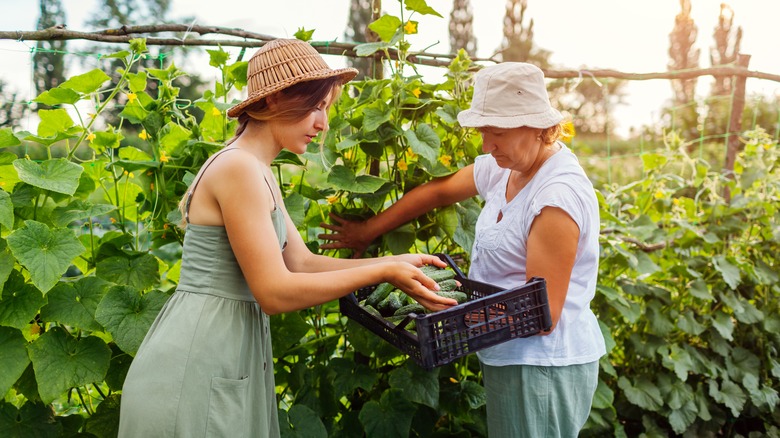The Gardening Hack That'll Help With Growing Melons And Other Vining Plants
If you read terms like vining, sprawling, climbing, or rambling in a plant description, you have a big choice to make as the plant begins to take root. You can either allow it to spread horizontally across the ground, or you can encourage it to take an upward path. When you grow fruits, vegetables, and flowers vertically, you open the door to a number of surprising benefits for the plant and the planter.
Vertical gardening, first and foremost, helps yield a healthier crop. Vining plants need a lot of room to grow properly. When these plants are on the ground, they're forced to compete for space, and this battle often results in a poor or nonexistent crop. Planting upward on a trellis won't introduce this spatial spat. Raising a crop off the ground also allows for more sunlight to reach the leaves and more air to circulate around it. While vining varieties often need a lot of water, you don't want the crop to wallow in wet soil. More air circulation keeps the crop dry and thus less susceptible to mold and pests — and, ultimately, disease.
Why vertical growth benefits the gardener
Gardeners benefit from vertical planting in a number of ways, too. Typically, when you start to grow one plant, you'll want to grow another and then another and then... well, you get the picture. Training plants to grow upward rather than outward can help to maximize your space. Pair a trellis with a raised planter bed to garden on a balcony, or space them across the backyard for a plethora of growing stations. As long as there's plenty of soil, you can even place bush crops below the vines for maximum results.
Your body and your mind will also thank you for these vertical plants. When it's time to harvest, you won't have to bend, kneel, and stretch to reach those fruits and vegetables; simply walk up and snip! Gone are the fears of pesky varmints and slithering reptiles too. They could still be present, of course, but you'll have much better visibility as you reach through the leaves and vines.
Best practices for growing fruits and vegetables vertically
Fruits, vegetables, and flowers are inherently adept at growing upward. Tomatoes are often the first that come to mind, but there are also members of the cucurbit family — think melons, cucumbers, and squash — as well as peas, beans, and even sweet potatoes. Each of these will have its own growing specifics, but there are two general rules of thumb: Most vining plants need full sun for at least six hours a day and more water than their horizontal counterparts.
The type of structure used is also vitally important. You can choose to use a trellis for your vegetables and fruits, likely the most commonly selected option, but you can also utilize livestock panels, arches, fences, and tent poles. When deciding which structure is right for you, consider how heavy the vegetable or fruit will be just before it's ripe for picking. Melons will need sturdier support than peas, for example. For those heavier crops, you may want to consider building your own structure or reinforcing an existing one.


